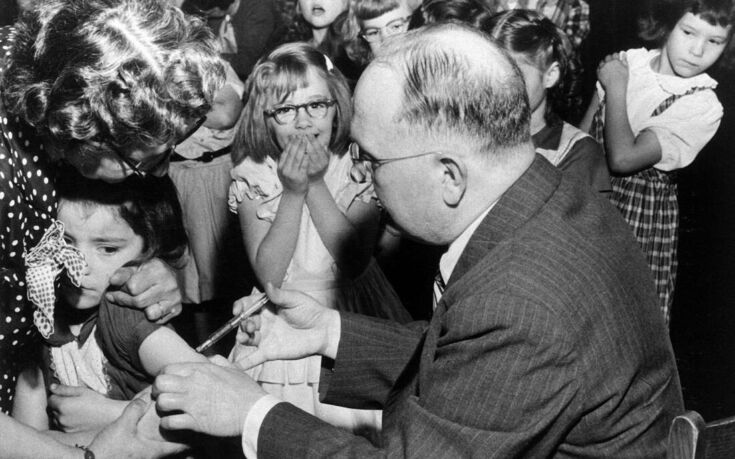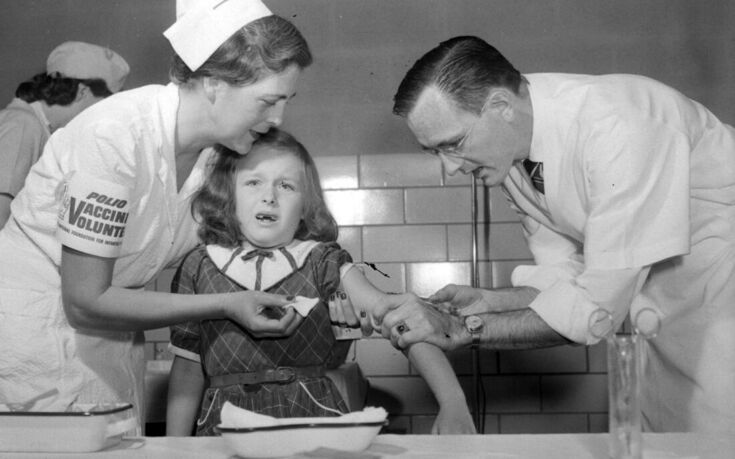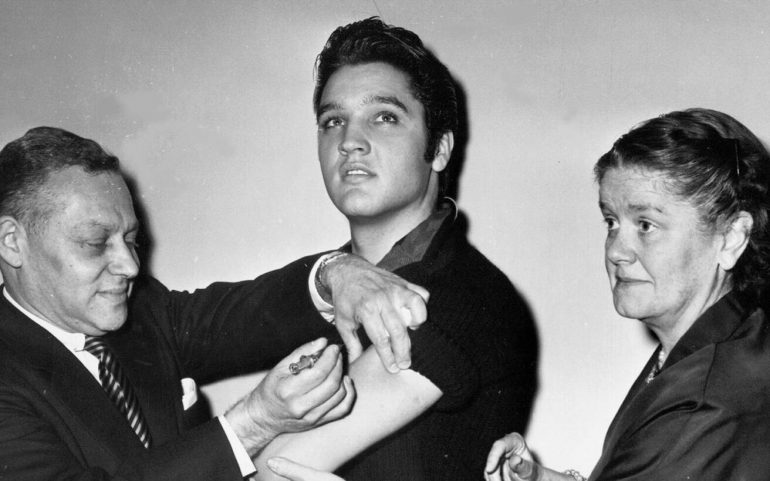Η May 14, 1796 is a defining date in the history of mankind.
It was the day that Edward Jenner from a simple English doctor he suddenly became the undisputed "father of modern immunology" saving (future) millions of lives.
Jenner was born on May 17, 1749, in the small town of Berkeley, Gloucestershire. After completing his studies in 1773, he returned to Berkeley and began practicing medicine. Jenner was very observant, as he had many activities that required observation, such as studying plants and collecting fossils.
In his area it was very common for cattle to be infected with vaccinia, which is a form of smallpox that mainly affects cattle.
In 1788, the smallpox epidemic in Gloucestershire was very intense and Jenner noticed that those farmers who had contracted the -very milder- vaccinia were not affected by smallpox, while on the contrary those who were infected had never been ill with vaccinia.
His remarks were brought to the attention of great medical scientists, but they did not pay attention to Jenner's conclusion that the vaccinia germ creates immunity to smallpox, attributing the cases he mentioned, to a simple coincidence.
With experiments found that vaccinia could be transmitted from one person to another through vaccination. He was sure of that the vaccinated person would not be afraid of catching smallpox, but he could not find anyone to accept a vaccinia vaccine.
He was given the opportunity when a young farmer visited him with symptoms of hepatitis. Jenner carefully took the fluid from the ulcers that had appeared on the young woman's hand and decided to transfuse it into the body of a healthy person. He believed that the microorganisms that caused vaccinia would make the body of a healthy person capable of dealing with a future smallpox case.

At On May 14, 1796, Jenner performed his experiment on eight-year-old James Phipps., who was the son of his gardener. To Jenner's surprise, his gardener agreed to conduct the experiment.
Jenner somehow vaccinated him Pips with vaccinia germ. If the his theory was correct, James he would never get smallpox. So, Jenner made two small superficial incisions in the little boy's left arm and smeared them with the liquid he had removed from the young farmer. Then he bandaged his arm.
Little James contracted a very mild form of vaccinia. The following July, when the little one was fully recovered, Jenner vaccinated him again, this time with a normal smallpox virus. The little one was not infected with smallpox and so Jenner had the confirmation of his theory. Jenner did not hesitate to repeat the experiment to other children, including his 11-month-old son. After the success of the experiment, many accepted without difficulty to vaccinate them against smallpox.
In 1797 he submitted the results of his research to the Royal Society, which rejected them. In 1798, Jenner resubmitted his discoveries and the Society approved the their publication, which took place under the title "Research on the causes and effects of smallpox" (An Inquiry into the Causes and Effects of the Variolae Vaccinae).
Jenner called the process vaccination (vaccination) from the name of the virus variolae vaccinae, which means in Latin "Smallpox of cows", while he was also first to use the term virus (virus).
His publication was not welcomed. On the contrary, he was insulted by almost the entire press, while the attack he received from the Εκκλησία who claimed that "Vaccination was an abominable act and against the divine will."
Shortly afterwards, and despite the reactions, the vaccine was introduced at St. Thomas Hospital. In practice, it was first used in the British Army and Navy, and then spread throughout England. The method quickly spread to both the United States and the rest of Europe.
Now, two centuries later, his discovery is believed to have saved more lives than any other.

How much vaccines have changed the course of humanity for the better, of course, admits Korando Outzas in his text in "La Repubblica».
The Italian writer and journalist cites the deadly plague epidemic that struck Milan from 1629 to 1631 - not so much because more than a million people died but because for the first time evil was not interpreted as a divine punishment but as a "consequence of human malice or nonsense ", and although the spread of the pandemic in the wider area contributed (almost exclusively) to the oligarchy of local authorities to take action against the disease.
"In this adventurous war between humanity and viruses, I confess that I was very impressed by the story of the plague victims of the 17th century plague brought to Milan by the German mercenaries of that time. To attribute the cause of the plague to a bunch of bad or selfish men who supposedly went to knowingly poison the crowds is clearly nonsense. But behind this absurd explanation lies a crude popular interpretation of that time, where evil is no longer seen as the result of divine wrath, but an affliction stemming from human wickedness or stupidity. The transmission of the cause of the plague "from heaven to earth" was a precondition for the people of that time to imagine that they could cure it., as soon as the tools are found. And these came, with the discovery of the microscope and the world that emerged from what came under it. "It took many years between the first experiments with a pair of lenses glued to a metal tube until the invention of a real microscope capable of detecting viruses," said Autzas in his lengthy article.
"These little devices, microscopes revealed to us a world that no one had ever suspected existed. A drop of vinegar under the tiny lens revealed that it was inhabited by tiny eels. Likewise a drop of blood, a drop of semen, a fly eye, a little stagnant water. "We discovered viruses, we learned to analyze them, to treat them with vaccines", the Italian concludes meaningfully.

The first epidemic smallpox, also known as Variola (from the Latin word "varus" meaning "mark on the skin"), mentioned in history occurred in 1.350 BC. in ancient Egypt and Asia. THE Pharaoh of Ramses the fifth died of smallpox in 1.157 BC. as signs of smallpox were found on the mummy of.
In the 18th century, more than 60 million people died of smallpox in Europe alone. One third of those who survived were left blind. The fact that people who survived the disease did not get sick again pushed one Buddhist nun in China (1022-1063), to take smallpox scraps, place them in powder and blow them on the nose of healthy people (Variolation). This practice continued until 1800 in many Asian countries. In Europe it began in 1710 and continued until the discovery of the vaccine.
Somehow, the The last smallpox epidemic occurred in 1967 with 15 million patients and 2 million deaths. That year the World Health Organization launched a global campaign to reduce and eradicate the disease. Systemic administration of the vaccine began on a global basis only in 1956.
Mass vaccinations were very effective and the last case of smallpox occurred on October 26, 1977 in Somalia, while the last death was recorded on September 11, 1978 in a laboratory in Birmingham due to accidental infection. The vaccine continued for another two years and ended with the announcement of the World Health Organization in Geneva on 8 May 1980 on the complete elimination of smallpox worldwide.

Likewise with cholera, a disease caused by the cholera bacterium Vibrio cholerae and characterized by severe diarrhea, which can cause severe dehydration. It is due to the consumption of water, milk, or food that has become contaminated due to the unhealthy operating modes of the water supply and sewerage systems.
The first to discover the cholera bacterium was Italian physician Filippo Pacini in 1854, during an epidemic in Florence. Unfortunately, the Italian medical community completely ignored his discovery, because they did not believe that diseases such as cholera were caused by germs. In the same year o British doctor John Snow proved that cholera was transmitted through contaminated water - especially from the stagnant waters of the Thames - and not through the air as believed at the time.
In 1865, during a cholera epidemic in Marseille, ο Louis Pasteur did a series of experiments to detect the germ but to no avail. The cholera bacterium was finally rediscovered in 1883 by the German physician Robert Koch, convincing the medical community that diseases such as cholera were indeed caused by germs.
1879, c Charles Samberlan, Pasteur's assistant, accidentally discovered it cholera vaccine. He vaccinated chickens with a vaccine made from an old crop of material from chickens suffering from cholera and found that the vaccinated chickens were not sick. Although the vaccine was discovered in 1879, the first cholera vaccines were released in 1917.
There have been a total of seven cholera pandemics from 1817 to 1970. A total of more than 1817 million people have died from cholera since 45, including the famous composer. Piotr Ilyich Tchaikovsky who died of cholera on November 6, 1893 at the age of 51.
Polio appeared in prehistoric times. Paintings and reliefs show people with paralysis in ancient Egypt. In 1916 more than 9.000 cases were recorded in New York.
In 1921 the later President of the United States, Franklin Roosevelt is infected with polio at the age of 39 years. When he was elected President of the United States in 1932, he successfully concealed his disability throughout his presidency. The photos usually showed him from the middle up!
In 1934 a new epidemic occurred in Los Angeles, with over 3.000 cases, while the next major epidemic occurred after World War II with 20.000 cases (1945-1949). In 1952-53 a new major epidemic occurred in all 48 states of the United States with 93.000 cases, 5.000 deaths and more than 30.000 paralysis, the vast majority of children aged 8 to 16 years.
In 1935 the first attempt to make the vaccine was made with complete failure. The vaccine itself caused severe and deadly polio. The first effective polio vaccine was made in injectable form by Jonas Schalk in 1954 in Pittsburgh of the USA using dead viruses. Its administration began the following year.
The 1959 Albert Sabin manufactures and tests the new vaccine with great clinical success and in 1962 completely replaces the Schalk vaccine. New vaccine was administered orally and was considered more effective. Mass vaccination of this vaccine in 1961 and 1963 contributed to the dramatic decline in polio cases worldwide, from 350.000 cases in 1988 to 1.170 in 2004 and only 105 in 2005. (Sudan, Nigeria). In 1993 and 1994 in India and China alone, 163 million children were vaccinated in just a few days (polio week).
By 1995, 140 countries had been declared by the World Health Organization as free from polio.
Today, polio is endemic in four countries, India, Pakistan, Afghanistan and Nigeria, while sporadic cases are still occurring in 30 other African and Asian countries. In recent years, within the framework of the Global Polio Eradication Initiative (GPEI), mass vaccinations are being carried out in these countries with the aim of completely eradicating the disease in the next five years, by 2025.
